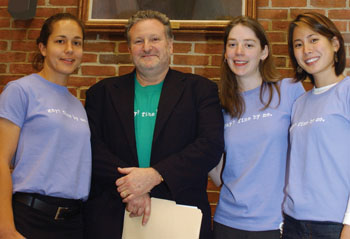
Marshall Forstein, M.D., associate professor of Psychiatry at Harvard, with Vanderbilt medical students Annie Antar, Diana Lemly and Andrea Li at his lecture last week.
Photo by Mary Donaldson
Gay and lesbian patients subject of lecture
Saying that the most significant health risk for the gay and lesbian community is avoiding health care, a Harvard professor told students at the Vanderbilt School of Medicine that they need to “do no harm” and maintain a non-judgmental attitude when providing care to gay patients.
Marshall Forstein, M.D., associate professor of Psychiatry at Harvard Medical School and the director of Psychiatric Residency Training at the Cambridge Hospital, made his comments before an audience of more than 175. His lecture was titled, “What every medical student should know about caring for gay and lesbian patients.”
With many in the audience wearing T-shirts that sported “Gay? Fine by me.” the Light Hall auditorium was filled with medical school students, current physicians, nurses, and other hospital professionals.
“Did you know that 44 percent of men who are gay and go to the doctor do not tell their doctor they are gay?” he said. “Did you realize that gay men have higher rates of cardiovascular disease?”
Forstein, mixing humor, science and experience, went on to tell the audience that they could best get to know their patients by not making assumptions, and to ask them, “Who in your life is important to you?”
“Questions like that have a purpose,” he said. “Knowing the people that are important in our patients’ lives help us provide better care. By asking it in that manner, you do so in a non-judgmental manner.”
The lecture and T-shirt wearing event was organized by three medical students – Annie Antar, a fourth-year student; Diana Lemly, a second-year student and Andrea Li, who is in her first year.
Antar, who along with Chris Kidd, is co-president of the Vanderbilt School of Medicine Gay-Straight Alliance, said she hoped the lecture would help make better physicians.
“The response to the lecture was tremendous,” she said. “This was such a big push for diversity.”













